Natural flower oils made without solvents give you the purest therapeutic benefits while protecting your health and the environment. You'll get clean, chemical-free extracts that maintain the authentic aroma profiles and healing properties of flowers. These oils work better for sensitive skin and won't trigger allergic reactions from harsh synthetic residues. Traditional solvent-free methods like steam distillation and cold pressing guarantee you're getting nature's healing power in its most potent form. Discover how these pure extracts can transform your wellness routine.
The Power of Pure Flower Essences
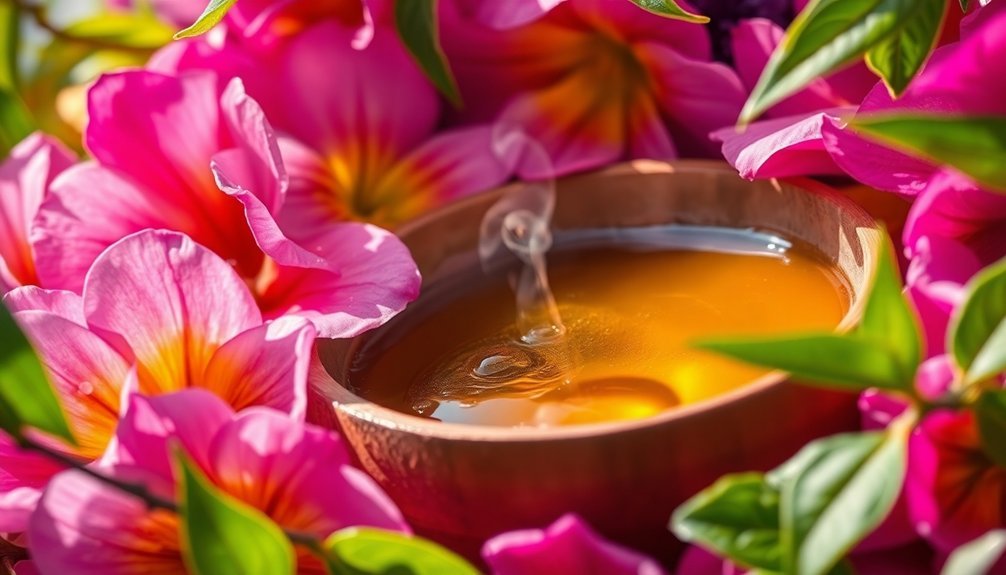
While modern medicine often relies on synthetic compounds, flower essences offer a gentle yet powerful approach to healing through nature's vibrational energy.
These pure extracts capture the energetic imprint of flowers using only spring water and sunlight, without any physical plant material or chemical solvents. This method originated from Dr. Edward Bach's work in the 1930s.
You'll find that flower essences work on multiple levels of well-being. They can reduce your anxiety, improve your mood, and help manage pain by addressing the emotional roots of physical discomfort.
Beyond emotional benefits, they're enhancing your spiritual connection and fostering personal growth.
You can safely use them in various ways – from oral drops to bath additions – and they'll complement your existing wellness practices like meditation or yoga.
The best part? They're safe for everyone, including children and pets.
Understanding Solvent-Free Extraction
You'll discover that solvent-free extraction methods harness the pure essence of flowers without using harsh chemicals.
These natural methods, including steam distillation and cold pressing, preserve the flowers' authentic aroma profiles while ensuring your oils remain free from potentially harmful residues. Heat and pressure techniques have revolutionized extraction by utilizing precise temperature control to release essential compounds.
Pure Botanical Goodness
When it comes to natural flower oils, solvent-free extraction methods represent the purest approach to capturing botanical essences.
You'll find these methods preserve the delicate aromatic compounds of flowers while maintaining their true, characteristic scent. The absence of chemical solvents means you're getting oils free from harmful residues and contaminants.
The process prevents enzymatic oxidation and lipid autoxidation, ensuring your oils retain their therapeutic benefits and antioxidant properties.
Whether it's through steam distillation, mechanical pressing, or cold pressing, you're receiving a product that's undergone minimal processing. These methods can be completed quickly, reducing the risk of compound degradation. Arab culture pioneered these extraction techniques by introducing distillation methods mixing plant material with ethyl alcohol.
For health-conscious consumers, this means you're getting pure botanical oils with enhanced therapeutic properties and a reduced risk of allergic reactions.
Safe Infusion Methods
Safe infusion methods bring solvent-free extraction within reach of both beginners and experienced practitioners. You'll find the perfect method based on your needs and materials.
| Method | Best For |
|---|---|
| Cold Infusion | Delicate herbs, flowers; preserves volatiles |
| Warm Infusion | Tough materials like roots and bark |
| Steam Distillation | Pure essential oils and hydrosols |
| Solventless Extraction | Chemical-free concentrates |
Cold infusion takes longer but protects sensitive compounds, while warm infusion speeds up the process for hardier materials. Steam distillation captures pure essential oils without chemicals, producing useful hydrosols as a bonus. These methods guarantee you're getting clean, pure extracts without harmful residues. You'll maintain the therapeutic properties of your botanicals while creating safe, high-quality products that are free from synthetic contaminants.
Health Benefits of Chemical-Free Oils
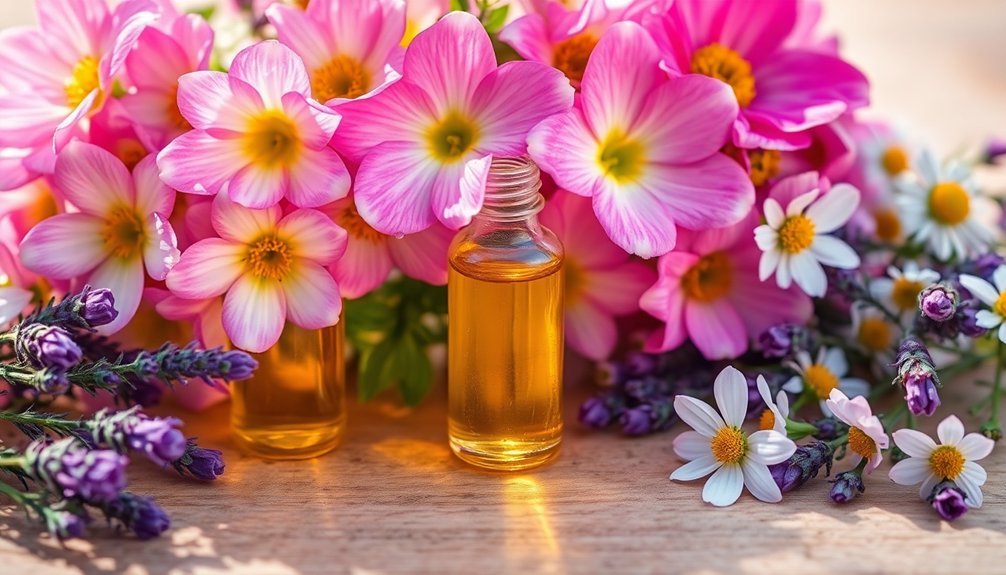
Chemical-free flower oils work perfectly for your sensitive skin, as they're free from harsh synthetic residues that could trigger irritation or allergic reactions.
You'll benefit from the oils' natural defense properties, which help protect your skin against environmental stressors while supporting its natural healing processes.
The pure, unaltered essential compounds in these oils deliver their therapeutic benefits directly to your skin without interference from artificial additives or chemical solvents.
Safe for Sensitive Skin
Natural flower oils provide exceptional benefits for sensitive skin because they're derived purely from plant sources without harsh solvents or chemicals.
These gentle oils work in harmony with your skin's natural balance, delivering deep moisturization and essential nutrients without causing irritation. You'll find rich concentrations of vitamins, antioxidants, and minerals that protect and repair your skin while fighting signs of aging.
Unlike synthetic products, these oils won't strip away your skin's natural protective barrier or introduce harmful toxins into your system.
- Soothes conditions like eczema, psoriasis, and rosacea
- Contains natural anti-inflammatory properties to calm irritated skin
- Supports your skin's lipid barrier with nourishing fatty acids
- Provides deep moisturization without clogging pores
- Eliminates risk of chemical-induced allergic reactions or sensitivities
Natural Defense System
When addressing your body's protective mechanisms, flower oils derived without solvents offer a powerful arsenal of health benefits.
You'll find that natural floral oils like rose, lavender, and chamomile provide anti-inflammatory and antiseptic properties that combat skin irritation, allergies, and bacterial infections. These oils work with your body's natural defense systems without disrupting hormonal balance, unlike synthetic alternatives containing harmful phthalates.
Beyond physical protection, they'll strengthen your mental defenses too. When you inhale these natural fragrances, they trigger endorphin release, helping reduce stress and anxiety while promoting better sleep.
Pure Essential Benefits
The health advantages of solvent-free flower oils extend far beyond basic defense mechanisms.
You'll find that natural flower oils provide therapeutic benefits without the risks associated with concentrated essential oils. These gentler alternatives offer effective skincare solutions while supporting your body's natural balance, unlike harsh essential oils that can disrupt hormones or damage your skin's microbiome when used incorrectly.
- Nourishes your skin with natural antioxidants and vitamins without the need for dilution
- Provides anti-inflammatory and anti-histamine properties through whole plant compounds
- Supports sustainable practices by reducing the demand for resource-intensive essential oils
- Offers aromatherapeutic benefits without the risk of chemical sensitivities
- Creates a versatile, chemical-free solution for skin, hair, and nail care that you can easily make at home
Traditional Methods for Oil Infusion
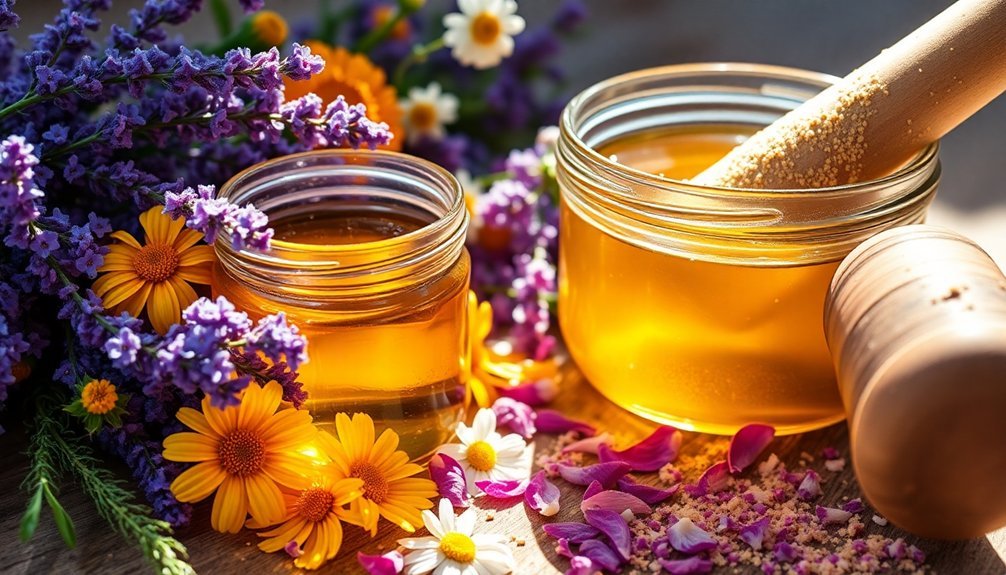
Throughout history, traditional oil infusion methods have provided reliable ways to extract beneficial compounds from flowers and herbs without harsh chemicals.
You'll find three main approaches to oil infusion: cold, sun, and heat methods. The cold method requires you to store herbs in oil for six weeks in a dark place, while the sun method needs a sunny windowsill and daily stirring for four to six weeks.
If you're short on time, try the heat method using a double boiler for 30-60 minutes.
For all methods, you'll need to completely cover your plant material with carrier oil and strain through cheesecloth when finished. Remember to use clean containers, organic materials when possible, and label everything with dates.
Store your finished oils in a cool, dark place to maintain their quality.
Selecting the Right Flowers and Base Oils
Choosing appropriate flowers and base oils makes all the difference in creating high-quality natural infusions. You'll want to take into account both the botanical source and aromatic properties when selecting flowers, as different parts of plants yield distinct essential oils.
For base oils, opt for non-toxic vegetable options like linseed or safflower oil, which provide safe, solvent-free applications.
- Select heat-sensitive flowers like jasmine and tuberose for gentle extraction methods
- Check the flowers' pollination patterns to understand their natural oil production cycles
- Choose base oils that match your desired drying time and consistency
- Verify chemical compatibility between your chosen flowers and base oils
- Source your materials from certified suppliers who provide clear labeling and quality guarantees
Natural Preservation Techniques
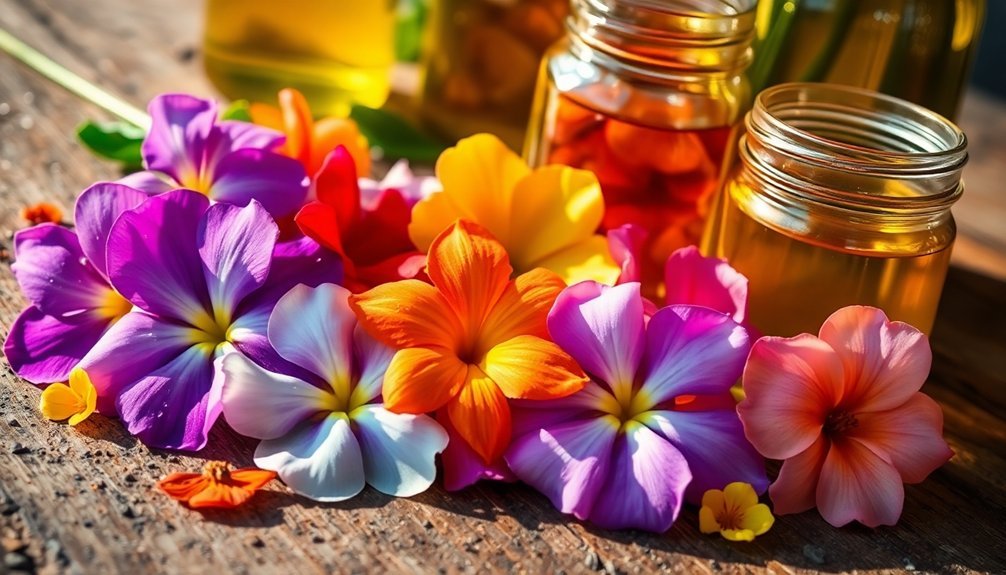
When preserving natural flower oils, selecting the right preservation technique guarantees your infusions maintain their potency and shelf life.
You'll find freeze-drying to be one of the most effective methods, as it preserves flowers between -4 and -112° Fahrenheit with minimal chemical intervention. This process takes about 14 days but yields exceptional results for over 90 flower varieties.
If you're seeking a more accessible approach, try the double immersion method. First, dehydrate your flowers in pure alcohol for 24 hours, then rehydrate them using a solution of alcohol, propylene glycol, and glycerin.
For a simpler option, you can use glycerin immersion, heating your solution to 104°F. While it's less reliable long-term, it's cost-effective and allows for color restoration using natural food coloring.
Environmental Impact of Clean Extraction
Despite their natural origins, flower oil extraction methods can greatly impact the environment. Traditional methods like steam distillation require massive amounts of plant material and consume significant water and energy resources. For example, you'll need 220 pounds of lavender flowers to produce just one pound of essential oil.
Clean extraction methods, however, can help minimize environmental damage while preserving the potency of flower oils.
- Cold pressing uses less energy than steam distillation while maintaining oil quality
- Ultrasound and microwave-assisted extraction reduce processing time and energy consumption
- Sustainable wild harvesting protects biodiversity and prevents species depletion
- Organic farming practices eliminate harmful pesticides and preserve soil health
- Modern extraction techniques minimize waste and reduce your carbon footprint
Creating Your Own Floral Blends

Building on the principles of clean extraction, you can harness the power of floral oils to craft your own signature blends at home.
You'll find that creating personalized combinations allows you to target specific therapeutic benefits while maintaining an eco-friendly approach to wellness.
Start by selecting your favorite floral essential oils, such as lavender, rose, or jasmine. You can blend these with other scent families like citrus or woody notes to create a balanced aromatherapy experience.
Remember to dilute your blends with carrier oils for safe topical application. Whether you're making a relaxing massage oil, a calming diffuser blend, or a natural perfume, you'll enjoy the flexibility of adjusting proportions to suit your needs.
This hands-on approach guarantees you're using pure, chemical-free ingredients while supporting a sustainable lifestyle.
Frequently Asked Questions
How Long Does It Take for Flower Oils to Show Visible Results?
You'll notice initial scalp improvements within 4-6 weeks, but visible hair growth takes 2-3 months of consistent use. For ideal results, you'll need to maintain regular applications for up to 6 months.
Can I Use Fresh Flowers From My Garden for Making Oils?
Yes, you can use fresh flowers from your garden, but you'll need to guarantee they're clean and free from bugs. Harvest them in the morning after dew has dried, and remove any dirt or calyxes.
Are Natural Flower Oils Safe During Pregnancy?
While some flower oils can be safe during pregnancy, you'll need to be cautious. Always consult your healthcare provider first, avoid use in the first trimester, and only use properly diluted oils from trusted sources.
What Happens if My Flower Oil Starts to Smell Different?
If your flower oil's smell changes, it could indicate spoilage, contamination, or improper storage. You'll want to check the storage conditions, expiration date, and discontinue use if you notice any concerning changes.
Can I Mix Different Base Oils for a Single Flower Infusion?
Yes, you can mix different base oils for your flower infusion. Just verify they're compatible and well-blended before adding your flowers. This can help you achieve specific therapeutic benefits and desired consistency.
In Summary
Making your own solvent-free flower oils puts you in control of what goes into your natural wellness products. You'll avoid harmful chemicals while preserving the flowers' pure therapeutic properties. By choosing traditional extraction methods, you're protecting both your health and the environment. Whether you're creating massage oils, skin care products, or aromatherapy blends, you're embracing an age-old practice that delivers truly pure botanical benefits.


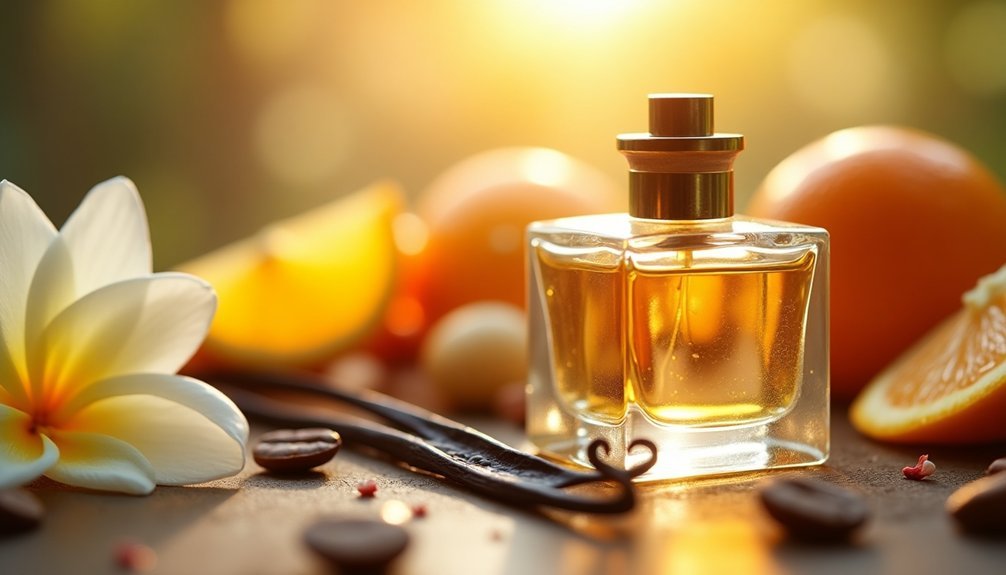

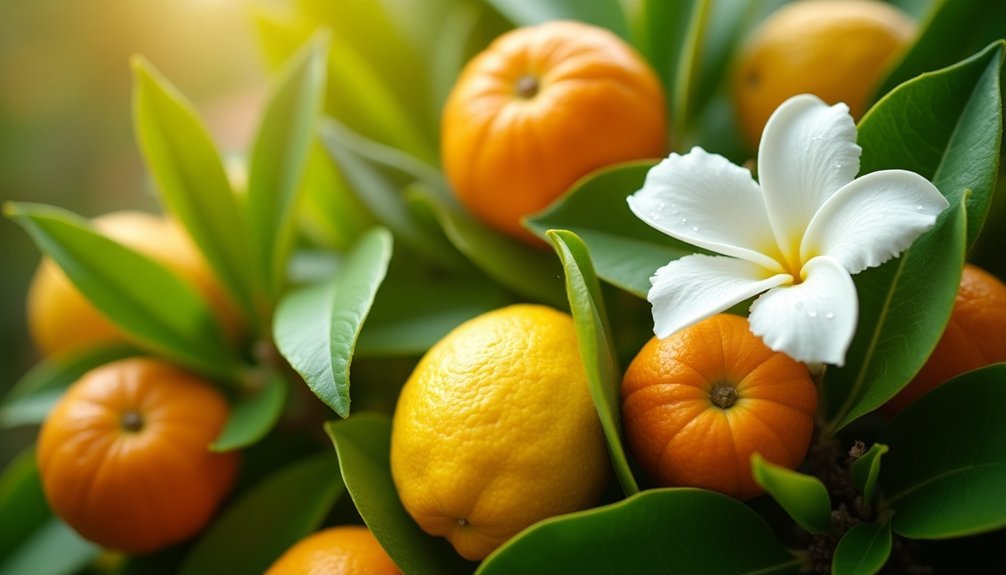
Leave a Reply